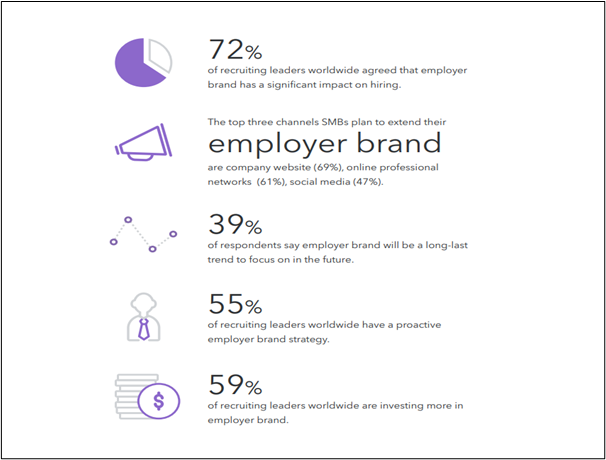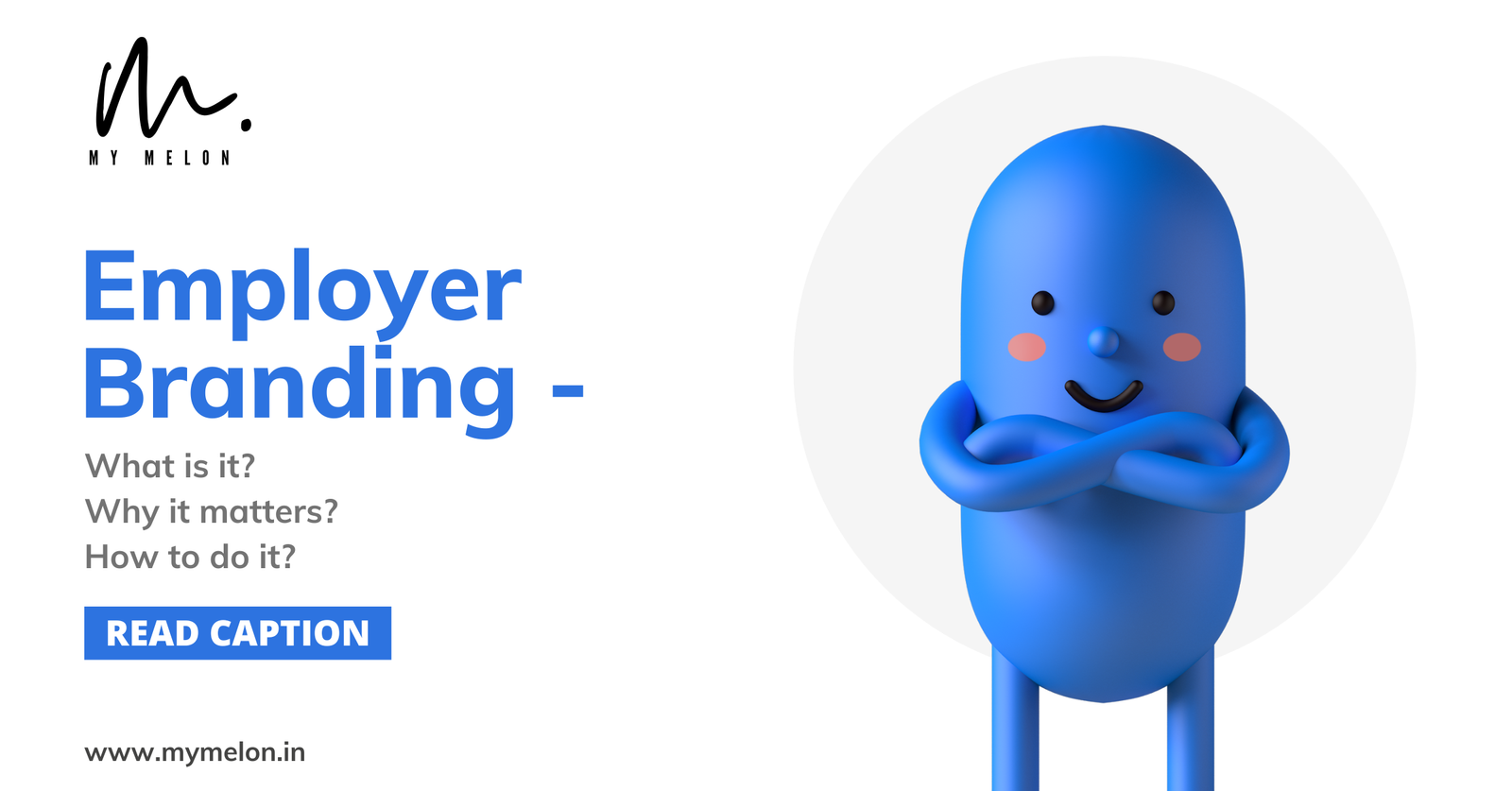The fight to attract and retain top talent has never been fiercer than it is now, in a fiercely competitive job market.
Let’s consider two companies. One is renowned for its vibrant culture, where employees rave about their work-life balance and career growth opportunities. The other? Well, it’s just another company that spends plenty of time in just creating a compelling brand story around its products or services and has little to no presence or buzz about what it’s like to work there.
Which company do you think will attract the best talent..?
In a world where professionals are increasingly looking for workplaces that align with their values and provide a positive experience, the first company is bound to stand out in not only attracting but also retaining the best and brightest.
What is Employer Branding?
By now, you may have a better understanding of employer branding—a process that involves promoting your company as an ideal employer to the target group you wish to attract, recruit, and retain.
It’s the way your company is perceived by current and potential employees, encompassing everything from your company’s mission and values to its work culture and growth opportunities.
Moreover, 89% of workers at companies that support well-being initiatives are more likely to recommend their company as a good place to work
In essence, a strong employer brand is like a magnet that attracts top talent and keeps your existing employees engaged and loyal. It’s not just about what your company does, but how it does it, and how that resonates with your workforce.
Why is Employer Branding Important?

SMB Employer Brand Landscape
1. Attracting Top Talent…
When your company is known as a great place to work, you’ll attract higher-quality candidates who are aligned with your company’s values and goals. A strong employer brand can reduce turnover rates by 28% and cut the cost-per-hire by half.
2.Employee Engagement and Retention…
A strong employer brand doesn’t just attract talent, it also keeps it. Employees who feel connected to their company’s mission and culture are more likely to stay engaged and committed. Gallup’s State of the Global Workplace report found that highly engaged teams show 21% greater profitability and a 41% reduction in absenteeism.
3. Enhancing Company Culture…
A well-defined employer brand reinforces your company’s culture. When your brand clearly communicates your values and work environment, it helps shape the behaviors and attitudes of your employees, creating a more cohesive and productive workplace.
4. Influencing Customer Perception…
A strong employer brand doesn’t just impact employees; it can also influence how customers perceive your business. Companies known for treating their employees well are often viewed more favorably by consumers.
In fact, a 2022 report by Edelman found that 60% of consumers said they would boycott a brand based on their perception of the company’s treatment of employees.
Employer Branding Strategies
Step 1… Define Your Employer Value Proposition (EVP)
Your Employer Value Proposition (EVP) is the core of your employer brand. It’s the unique set of benefits and values that you offer your employees in return for their skills, experience, and commitment. Your EVP should answer questions like:
- What makes your company unique?
- Why should someone work for you instead of another company?
- What do your current employees value most about working at your company?
Take Microsoft, for instance. Their EVP emphasizes the company’s mission to “empower every person and every organization on the planet to achieve more.” This mission-driven approach resonates with employees who are passionate about technology and making a global impact.
Step 2… Conduct Internal and External Research
Before you build your employer brand, you need to understand how your company is currently perceived by both current employees and potential candidates. Conduct surveys, focus groups, and one-on-one interviews with employees to gather insights about their experience at your company.
Externally, research how your competitors are positioning themselves. Analyze their job postings, careers pages, and employee reviews. This will help you identify areas where you can differentiate your brand.
Step 3… Develop a Comprehensive Employer Branding Strategy
Once you have your EVP and research insights, it’s time to develop a strategy. This should include:
- Clear Objectives: What do you want to achieve with your employer branding efforts? Whether it’s increasing application rates, improving employee retention, or boosting your Glassdoor rating, set measurable goals.
- Messaging Strategy: Craft messaging that aligns with your EVP and resonates with your target audience. This should be consistent across all channels, from job descriptions to social media posts.
- Content Creation: Develop content that showcases your company culture, values, and employee experiences. This could include employee testimonials, day-in-the-life videos, and blog posts highlighting your company’s mission and initiatives.
Salesforce is known for its strong employer brand, which is built around its commitment to equality, innovation, and giving back. The company regularly shares stories about its community involvement, employee resource groups, and inclusive culture on its careers page and social media channels, reinforcing its brand values.
Step 4… Implement Your Employer Branding Strategy
With your strategy in place, the next step is execution. This involves putting your messaging into action across various platforms:
- Careers Page: Your careers page is often the first place potential candidates will visit. Make sure it clearly communicates your EVP, highlights employee stories, and provides a seamless user experience.
- Social Media: Use platforms like LinkedIn, Instagram, and Twitter to share content that reflects your company culture and values. Engage with followers by responding to comments and questions, and encourage employees to share their experiences.
- Recruitment Materials: Ensure that your job descriptions, interview process, and onboarding materials all reflect your employer brand. Highlight the benefits of working at your company and what candidates can expect during the recruitment process.
Step 5… Monitor and Measure Your Employer Brand
Ever wondered why Google consistently ranks as one of the best places to work globally?
Google is a company that continually monitors and refines its employer brand. They use data-driven insights to enhance employee experience, from refining their office environment to offering unique perks that align with employee needs.
Building an employer brand isn’t a one-time effort; it’s an ongoing process that requires regular monitoring and adjustment. Track key metrics to assess the effectiveness of your employer branding strategy:
- Employee Engagement: Use surveys and feedback tools to measure employee satisfaction and engagement levels.
- Recruitment Metrics: Track application rates, time-to-hire, and quality of hire to gauge the impact of your employer branding on recruitment.
- Brand Perception: Monitor platforms like Glassdoor and LinkedIn for employee reviews and candidate feedback. This will give you insights into how your employer brand is perceived externally.
Employer Branding vs. Company Branding
| Aspect | Employer Branding | Company Branding |
| Definition | Promoting a company as an attractive employer to current and potential employees. | Promoting the company’s products, services, and overall image to customers and stakeholders. |
| Focus | Attracting, recruiting, and retaining top talent. | Building and maintaining a positive image of the company’s products or services. |
| Target Audience | Current and potential employees. | Customers, clients, investors, and general public. |
| Objectives | Enhance employee engagement, reduce turnover, and attract skilled candidates. | Increase brand awareness, drive sales, and build customer loyalty. |
| Channels | Careers page, job postings, social media, employee testimonials, recruitment events. | Advertising, public relations, social media, and promotional campaigns. |
| Metrics | Employee satisfaction, engagement levels, and recruitment metrics (e.g., time-to-hire, quality-of-hire). | Brand awareness, customer satisfaction, market share, and sales figures. |
| Example | Google’s employer brand highlights its innovative work environment and employee perks. | Apple’s company brand emphasizes cutting-edge technology and sleek product design. |
Best Practices for Employer Branding
1. Consistency Across Channels…
Ensure that your employer brand messaging is consistent across all platforms. Whether a candidate is looking at your LinkedIn page or your careers website, they should get the same impression of your company culture and values.
2. Engage Current Employees…
Your current employees are your best brand ambassadors. Encourage them to share their experiences on social media, participate in employee spotlight features, and refer potential candidates. Recognizing and rewarding employee advocacy can further strengthen your employer brand.
3. Leverage Employee Feedback…
Regularly gather feedback from employees to understand their needs, concerns, and satisfaction levels. Use this information to make improvements and demonstrate that you value their input. This can lead to higher engagement and a stronger, more authentic employer brand.
4. Showcase Company Culture…
Highlighting your company culture is key to attracting like-minded candidates. Whether it’s through videos, blog posts, or social media updates, showcase what makes your company a great place to work. This could include team-building activities, community involvement, or innovative projects.
So, whether you’re a small business or a global corporation, the principles of effective employer branding can assist you create a workplace that not only attracts the best candidates but also keeps your current employees
happy and engaged..!





